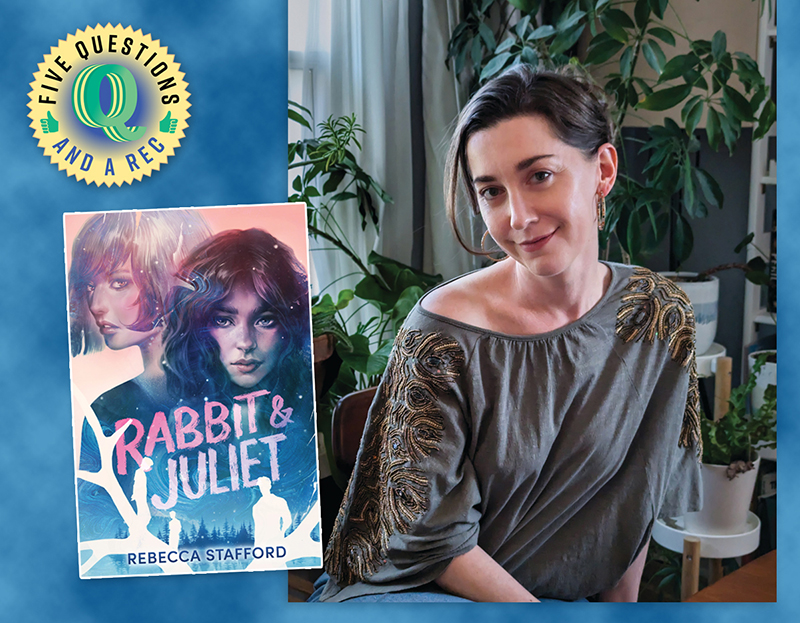Review of the Day – Just Right: Searching for the Goldilocks Planet by Curtis Manley, ill. Jessica Lanan
 Just Right: Searching for the Goldilocks Planet
Just Right: Searching for the Goldilocks Planet
By Curtis Manley
Illustrated by Jessica Lanan
Roaring Brook Press (an imprint of Macmillian)
$18.99
ISBN: 978-1-250-15533-7
Ages 6-10
On shelves now
I’m no teacher. I hold no degrees in any of the natural sciences. I serve on a math-related committee each year, but my knowledge of numbers is limited at best. Like many an English major, I became a librarian because on some level I figured it was the best possible escape from those subjects in which I’d only done passably well in school. Little did I suspect that by throwing my hat in with the children’s librarians I’d be privy to book after book of fascinating facts extolling the virtues of a whole host of sciences. Through children’s literature I’ve rediscovered a love of all those subjects I rejected when I was younger. Why? Because at this moment in time children’s nonfiction is stronger than it has ever been. We have a host of talented artists and authors finding innovative ways to make the sometimes intangible understandable. In reading these books, I have also discovered that what separates the wheat from the chaff, so to speak, is when the books don’t rely on cheap tactics like fake dialogue and those “alternative facts” that make for a better story, and are only corrected in the tiny type of an Afterword. There certainly is nothing cheap about Curtis Manley and Jessica Lanan’s Just Right: Searching for the Goldilocks Planet. With a title like that, I was half expecting a fictional mash-up of a classic fairytale and hard astronomical science. Instead, I found an enticing rendering of the world we live in, what makes it so special, and why we yearn to find other planets like our own, somewhere in the universe.
How special is our planet? It’s not the kind of thing you really think about, unless you’re ruminating over nature. Yet when it comes right down to it, Earth is more than a little amazing. It exists in our solar system’s “habitable zone” at just the right distance from the Sun. It has a molten core filled with enough iron to create a magnetic field (the perfect thing for protecting our atmosphere from solar winds). And then there’s that thick atmosphere that prevents our oceans from drying up, even while it holds our oxygen in place. Considering all these amazing features, is there any hope at all for life on other planets? To answer that question you need to look to the stars. As we watch, a young girl and her family go to the museum and consider massive telescopes and a Planetarium, and the girl starts to seriously imagine what life would be like on, say, one of the eleven billion Earth-sized exoplanets that scientists estimate are in our galaxy. Backmatter includes “The Science of Detecting Exoplanets” (already covered briefly in the text), questions like “What About Forms of Life Not Based on Carbon?”, a Selected Bibliography, books for Further Reading, Exoplanet Websites, Citizen-Science Websites, Amateur Astronomy Club and Star Party Websites, a note on “The Pace of Discovery”, and A Timeline of Discovering Our Place in the Universe, which extends from the front endpapers to the back.
ADVERTISEMENT
ADVERTISEMENT
 I have a rather unfortunate habit when I learn a really interesting new fact. When a normal person learns something new, they might bring it up with their friends at an appropriate moment. Perhaps there will be a pause in the conversation. Maybe the friend will be discussing something that has a tangential relationship to the fact that you have learned and you can bring it up naturally. With me, I aspire to be the kind of levelheaded conversationalist that knows the appropriate time and place to proffer some of the knowledge that I have learned. Instead, I seem to have absconded with all forms of impulse control, particularly when it relates to an interesting book. Last year, the book this happened the most with was Rachel Poliquin’s Beavers: The Superpower Field Guide (did you know they have see-through eyelids that act like goggles?!?). This year, this dubious honor falls to Just Right. I never in a million years would have predicted that a book about exoplanets could contain so many facts that are pertinent to what I see on a regular day-to-day basis. For example, it absolutely blows my mind that when you see a star “twinkle” that might be because an exoplanet has moved between you and the star’s light, blocking it out momentarily. That’s the kind of information that, were I a teacher, I’d be leaping around the classroom talking about, wildly. Roll your eyes all you want, kids. This book’s chock full of good stuff like that!
I have a rather unfortunate habit when I learn a really interesting new fact. When a normal person learns something new, they might bring it up with their friends at an appropriate moment. Perhaps there will be a pause in the conversation. Maybe the friend will be discussing something that has a tangential relationship to the fact that you have learned and you can bring it up naturally. With me, I aspire to be the kind of levelheaded conversationalist that knows the appropriate time and place to proffer some of the knowledge that I have learned. Instead, I seem to have absconded with all forms of impulse control, particularly when it relates to an interesting book. Last year, the book this happened the most with was Rachel Poliquin’s Beavers: The Superpower Field Guide (did you know they have see-through eyelids that act like goggles?!?). This year, this dubious honor falls to Just Right. I never in a million years would have predicted that a book about exoplanets could contain so many facts that are pertinent to what I see on a regular day-to-day basis. For example, it absolutely blows my mind that when you see a star “twinkle” that might be because an exoplanet has moved between you and the star’s light, blocking it out momentarily. That’s the kind of information that, were I a teacher, I’d be leaping around the classroom talking about, wildly. Roll your eyes all you want, kids. This book’s chock full of good stuff like that!
Again, I’m no scientist, but even I have been aware of the two different kinds of nonfiction titles for kids out there. In the first category you have you “narrative nonfiction” texts. These may include books for kids where the facts are presented like a story. Biographies and autobiographies are, by their very definitions, examples of narrative nonfiction. Now if you were to just limit a person’s life to their Timeline, that might be what they call “expository nonfiction”. These read like a series of facts, without the necessity of a storyline. When children’s book authors attempt to shoehorn in narrative aspects to expository information, the result is often extremely awkward (we’re not all capable of producing a Ms. Frizzle, people). Far more elegant is the solution I’ve seen with books like Just Right. Just look at how author Curtis Manley and illustrator Jessica Lanan straddle the narrative/expository canyon:
 Manley, to start, lets you know precisely what you’ve gotten yourself into with a Timeline on the front and back endpapers of this book. Then you turn the page and the illustrator is showing you a shot, from space, of our planet. On the next two pages we are zooming in on the land in four consecutive panels, finally landing on the image of a Black girl at her window, gazing at the sky, wondering about the likelihood that we’re alone in the universe. Essentially, Manley and Lanan are telling you from the get go that this book is going to have its cake and eat it too. You want facts? Manley steadfastly eschews any sort of story, even as he quotes astronomers and starts winnowing his way towards his thesis. It’s Lanan, the artist, who gives much of this text a more narrative feel. Her heroine is seen traversing the universe (if only in her head) thinking about cold, tiny, and/or soft planets. When her family takes a trip to the museum, her imagination takes her from molten cores to exoplanets like “WASP-12b”. And, in including this, Lanan is able to snag readers. Honestly, what she’s doing here is not all that different from some of Jason Chin’s books like Coral Reefs or his Caldecott Honor winning Grand Canyon. Like this book, those titles can be shelved in the nonfiction section because the storyline in the art almost exists on a different plane than the information written down. It’s simply a way of bridging the gap for those students that need a narrative to grasp facts.
Manley, to start, lets you know precisely what you’ve gotten yourself into with a Timeline on the front and back endpapers of this book. Then you turn the page and the illustrator is showing you a shot, from space, of our planet. On the next two pages we are zooming in on the land in four consecutive panels, finally landing on the image of a Black girl at her window, gazing at the sky, wondering about the likelihood that we’re alone in the universe. Essentially, Manley and Lanan are telling you from the get go that this book is going to have its cake and eat it too. You want facts? Manley steadfastly eschews any sort of story, even as he quotes astronomers and starts winnowing his way towards his thesis. It’s Lanan, the artist, who gives much of this text a more narrative feel. Her heroine is seen traversing the universe (if only in her head) thinking about cold, tiny, and/or soft planets. When her family takes a trip to the museum, her imagination takes her from molten cores to exoplanets like “WASP-12b”. And, in including this, Lanan is able to snag readers. Honestly, what she’s doing here is not all that different from some of Jason Chin’s books like Coral Reefs or his Caldecott Honor winning Grand Canyon. Like this book, those titles can be shelved in the nonfiction section because the storyline in the art almost exists on a different plane than the information written down. It’s simply a way of bridging the gap for those students that need a narrative to grasp facts.
I understand that Earth Day is a time when we celebrate the environment and why we should do everything in our power to keep it pristine. But if I may be so bold, perhaps another way of celebrating the day might be to make it clear just how rare our pretty planet really is. One of the many things Just Right does so well is that it shows us how strange and remarkable it is that it even came to exist in its current form at all. But what sets Just Right apart, however, and would make it a particularly fascinating read this coming Earth Day, is the amount of space it allows its child readers to speculate and wonder. We think about aliens all the time and what they might be like. Imagine actually finding other planets where they might live. That’s what Just Right does. It allows for the scope of possibility, even as its very message about the difficulty in finding planets like our own reinforces the fact that this place is pretty special. A book for narrative and expository readers alike.
On shelves now.
Source: Final copy sent from publisher for review.
Filed under: Best Books, Best Books of 2019, Reviews
About Betsy Bird
Betsy Bird is currently the Collection Development Manager of the Evanston Public Library system and a former Materials Specialist for New York Public Library. She has served on Newbery, written for Horn Book, and has done other lovely little things that she'd love to tell you about but that she's sure you'd find more interesting to hear of in person. Her opinions are her own and do not reflect those of EPL, SLJ, or any of the other acronyms you might be able to name. Follow her on Twitter: @fuseeight.
ADVERTISEMENT
ADVERTISEMENT
SLJ Blog Network
One Star Review, Guess Who? (#211)
Kevin McCloskey on ‘Lefty’ | Review and Drawn Response
Notable NON-Newbery Winners: Waiting for Gold?
The Seven Bills That Will Safeguard the Future of School Librarianship
Take Five: Newbery Picks, Part Two
Gayle Forman Visits The Yarn!
ADVERTISEMENT








Thanks for letting us know about this! As a product of growing up during the Mercury, Gemini and Apollo missions and of the original Star Trek, I’ve always been a nut for space exploration.